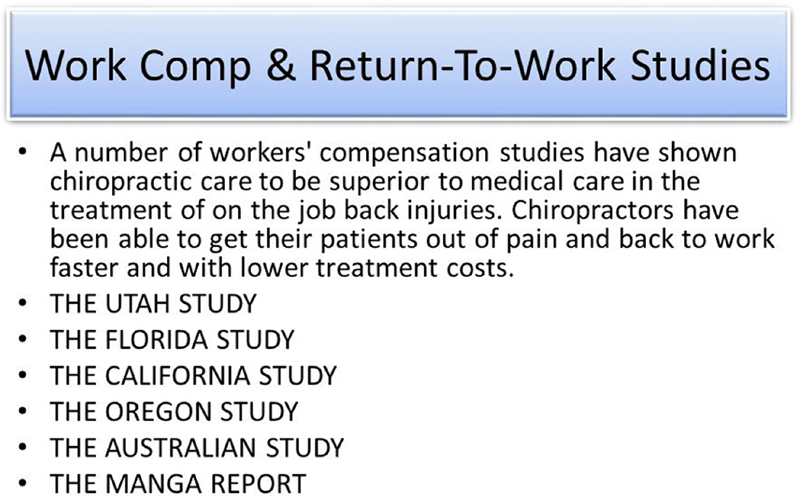Management of Neck Pain and Associated Disorders: A Clinical Practice Guideline from the Ontario Protocol for Traffic Injury Management (OPTIMa) Collaboration
SOURCE: Eur Spine J. 2016 (Mar 16) [Epub]
Côté P, Wong JJ, Sutton D, Shearer HM, Mior S et. al.
Canada Research Chair in
Disability Prevention and Rehabilitation,
University of Ontario Institute of Technology (UOIT),
2000 Simcoe Street North,
Oshawa, ON, L1H 7L7, Canada.
PURPOSE: To develop an evidence-based guideline for the management of grades I-III neck pain and associated disorders (NAD).
METHODS: This guideline is based on recent systematic reviews of high-quality studies. A multidisciplinary expert panel considered the evidence of effectiveness, safety, cost-effectiveness, societal and ethical values, and patient experiences (obtained from qualitative research) when formulating recommendations. Target audience includes clinicians; target population is adults with grades I-III NAD <6 months duration.
RECOMMENDATION 1: Clinicians should rule out major structural or other pathologies as the cause of NAD. Once major pathology has been ruled out, clinicians should classify NAD as grade I, II, or III.
RECOMMENDATION 2: Clinicians should assess prognostic factors for delayed recovery from NAD.
RECOMMENDATION 3: Clinicians should educate and reassure patients about the benign and self-limited nature of the typical course of NAD grades I-III and the importance of maintaining activity and movement. Patients with worsening symptoms and those who develop new physical or psychological symptoms should be referred to a physician for further evaluation at any time during their care.
RECOMMENDATION 4: For NAD grades I-II ≤3 months duration, clinicians may consider structured patient education in combination with: range of motion exercise, multimodal care (range of motion exercise with manipulation or mobilization), or muscle relaxants. In view of evidence of no effectiveness, clinicians should not offer structured patient education alone, strain-counterstrain therapy, relaxation massage, cervical collar, electroacupuncture, electrotherapy, or clinic-based heat.
RECOMMENDATION 5: For NAD grades I-II >3 months duration, clinicians may consider structured patient education in combination with: range of motion and strengthening exercises, qigong, yoga, multimodal care (exercise with manipulation or mobilization), clinical massage, low-level laser therapy, or non-steroidal anti-inflammatory drugs. In view of evidence of no effectiveness, clinicians should not offer strengthening exercises alone, strain-counterstrain therapy, relaxation massage, relaxation therapy for pain or disability, electrotherapy, shortwave diathermy, clinic-based heat, electroacupuncture, or botulinum toxin injections.
RECOMMENDATION 6: For NAD grade III ≤3 months duration, clinicians may consider supervised strengthening exercises in addition to structured patient education. In view of evidence of no effectiveness, clinicians should not offer structured patient education alone, cervical collar, low-level laser therapy, or traction.
RECOMMENDATION 7: For NAD grade III >3 months duration, clinicians should not offer a cervical collar. Patients who continue to experience neurological signs and disability more than 3 months after injury should be referred to a physician for investigation and management.
RECOMMENDATION 8: Clinicians should reassess the patient at every visit to determine if additional care is necessary, the condition is worsening, or the patient has recovered. Patients reporting significant recovery should be discharged.
There are more articles like this @ our:
Practice Guidelines Page and the:
Keywords Clinical practice guideline, Neck pain, Treatment, Management, Practice guideline, Therapies, Therapy, Disease management, Whiplash
Introduction
Background
More than 80 % of individuals experience neck pain and associated disorders (NAD) during their lifetime, with 30–50 % of the general adult population reporting neck pain annually. [1, 2] The course of neck pain is favorable for most people; however, 23 % of individuals who recover from an episode of neck pain will experience a subsequent episode. [3] For many patients, neck pain is a complex biopsychosocial disorder with problematic physical and psychological symptoms. Neck pain is associated with decreased health-related quality of life, decreased work productivity, daily activity limitations, and increased healthcare utilization. [2, 4-6]
In the United States, approximately 10.2 million visits are made annually to physician offices and hospital outpatient departments for neck pain. [7] In 2010, neck pain ranked fourth among all conditions contributing to years lived with disability. [8]
NAD that results from motor vehicle collisions is commonly known as whiplash-associated disorders (WAD). [8] In Canada, 86.2 % of people injured in motor vehicle collisions develop NAD. [6] Recovery from NAD can be prolonged and associated with high health resource use. [10, 11] Costs related to managing this condition are substantial due to medical costs and costs associated with productivity changes. [5, 12]
SOURCE: Read the rest of this Full Text article now!





Leave A Comment